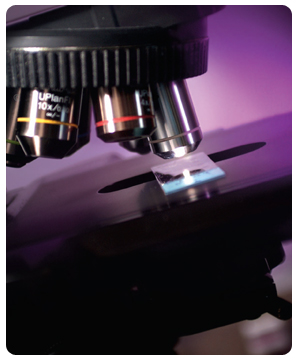
The laboratory report of the PGD chromosome screening will have a table (shown below) that lists the embryo number and the number of signals observed for each chromosome. After the list of observed signals for each chromosome, the individual result for the cell and, finally, the embryo will be listed to aid in decision making.
Normal embryos show two signals for the numbered chromosomes and either 2 X chromosomes (female) or 1 X and 1 Y chromosome (male). Abnormal embryos show a numerical abnormality of a single chromosome i.e. trisomy (three copies), monosomy (1 copy) or nullisomy (no copies). Embryos are said to have complex abnormalities if more than a single chromosome is abnormal. These embryos are also called chaotic, and are the most frequently seen abnormalities, comprising half of all abnormal embryos. This type of complex abnormality arises when an already abnormal embryo encounters additional abnormal cell divisions resulting in an almost random distribution of chromosomes in subsequent cells. Embryos with this type of chromosome abnormality will not produce ongoing pregnancies.
In order to obtain results of the biopsy, the cell removed must contain a nucleus, as the nucleus contains the genetic information necessary for testing. If the cell removed has no nucleus or if the nucleus ruptures during the extraction or fixation process, that cell cannot be scored for chromosome problems. As embryos are actively dividing, sometimes the biopsied cell contains two nuclei (as the cell was preparing to divide). Most often, embryos which contain such “binucleate” cells are abnormal. Both of these situations may not allow a PGD result to be interpretable for that particular cell. This is one of the reasons we try and take two separate cells to analyze whenever possible.
Those embryos considered to be unaffected on the basis of the PGD testing will then be available to be transferred into the woman's uterus or cryopreserved for future use.
The establishment of a diagnosis in PGD is not always straightforward. The criteria used for choosing the embryos to be replaced after FISH results are not equal in all centres. In some centres only embryos are replaced that are found to be chromosomally normal (that is, showing two signals for the gonosomes and the analysed autosomes) after the analysis of one or two blastomeres, and when two blastomeres are analysed, the results should be concordant.
Other centres argue that embryos diagnosed as monosomic could be transferred, because the false monosomy (i.e. loss of one FISH signal in a normal dipoloid cell) is the most frequently occurring misdiagnosis. In these cases, there is no risk for an aneuploid pregnancy, and normal diploid embryos are not lost for transfer because of a FISH error. Moreover, it has been shown that embryos diagnosed as monosomic on day 3 (except for chromosomes X and 21), never develop to blastocyst, which correlates with the fact that these monosomies are never observed in ongoing pregnancies.